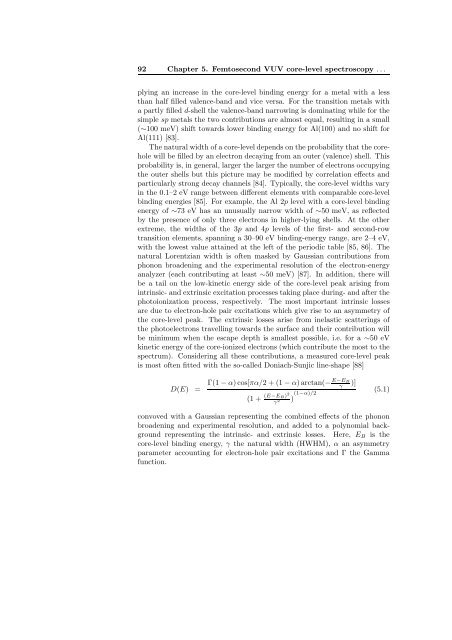VUV Spectroscopy of Atoms, Molecules and Surfaces
VUV Spectroscopy of Atoms, Molecules and Surfaces
VUV Spectroscopy of Atoms, Molecules and Surfaces
Create successful ePaper yourself
Turn your PDF publications into a flip-book with our unique Google optimized e-Paper software.
92 Chapter 5. Femtosecond <strong>VUV</strong> core-level spectroscopy ...<br />
plying an increase in the core-level binding energy for a metal with a less<br />
than half filled valence-b<strong>and</strong> <strong>and</strong> vice versa. For the transition metals with<br />
a partly filled d-shell the valence-b<strong>and</strong> narrowing is dominating while for the<br />
simple sp metals the two contributions are almost equal, resulting in a small<br />
(∼100 meV) shift towards lower binding energy for Al(100) <strong>and</strong> no shift for<br />
Al(111) [83].<br />
The natural width <strong>of</strong> a core-level depends on the probability that the corehole<br />
will be filled by an electron decaying from an outer (valence) shell. This<br />
probability is, in general, larger the larger the number <strong>of</strong> electrons occupying<br />
the outer shells but this picture may be modified by correlation effects <strong>and</strong><br />
particularly strong decay channels [84]. Typically, the core-level widths vary<br />
in the 0.1–2 eV range between different elements with comparable core-level<br />
binding energies [85]. For example, the Al 2p level with a core-level binding<br />
energy <strong>of</strong> ∼73 eV has an unusually narrow width <strong>of</strong> ∼50 meV, as reflected<br />
by the presence <strong>of</strong> only three electrons in higher-lying shells. At the other<br />
extreme, the widths <strong>of</strong> the 3p <strong>and</strong> 4p levels <strong>of</strong> the first- <strong>and</strong> second-row<br />
transition elements, spanning a 30–90 eV binding-energy range, are 2–4eV,<br />
with the lowest value attained at the left <strong>of</strong> the periodic table [85, 86]. The<br />
natural Lorentzian width is <strong>of</strong>ten masked by Gaussian contributions from<br />
phonon broadening <strong>and</strong> the experimental resolution <strong>of</strong> the electron-energy<br />
analyzer (each contributing at least ∼50 meV) [87]. In addition, there will<br />
be a tail on the low-kinetic energy side <strong>of</strong> the core-level peak arising from<br />
intrinsic- <strong>and</strong> extrinsic excitation processes taking place during- <strong>and</strong> after the<br />
photoionization process, respectively. The most important intrinsic losses<br />
are due to electron-hole pair excitations which give rise to an asymmetry <strong>of</strong><br />
the core-level peak. The extrinsic losses arise from inelastic scatterings <strong>of</strong><br />
the photoelectrons travelling towards the surface <strong>and</strong> their contribution will<br />
be minimum when the escape depth is smallest possible, i.e. for a ∼50 eV<br />
kinetic energy <strong>of</strong> the core-ionized electrons (which contribute the most to the<br />
spectrum). Considering all these contributions, a measured core-level peak<br />
is most <strong>of</strong>ten fitted with the so-called Doniach-Sunjic line-shape [88]<br />
D(E) =<br />
E−EB<br />
Γ(1 − α)cos[πα/2+(1−α)arctan(−γ )]<br />
(1 + (E−EB)2<br />
γ2 ) (1−α)/2<br />
(5.1)<br />
convoved with a Gaussian representing the combined effects <strong>of</strong> the phonon<br />
broadening <strong>and</strong> experimental resolution, <strong>and</strong> added to a polynomial background<br />
representing the intrinsic- <strong>and</strong> extrinsic losses. Here, EB is the<br />
core-level binding energy, γ the natural width (HWHM), α an asymmetry<br />
parameter accounting for electron-hole pair excitations <strong>and</strong> Γ the Gamma<br />
function.















